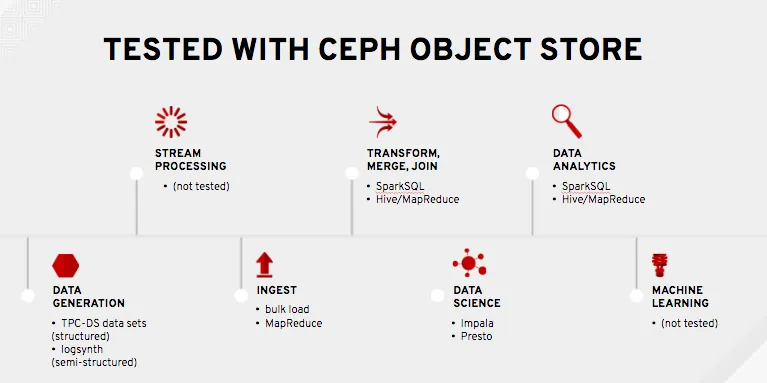Introduction
A couple years ago, a few big companies began to run Spark and Hadoop analytics clusters using shared Ceph object storage to augment and/or replace HDFS.
We set out to find out why they were doing it and how it performs.
Specifically, we wanted to know first-hand answers to the following three questions:
- Why would companies do this? (see “Why Spark on Ceph? (Part 1 of 3)”)
- Will mainstream analytics jobs run directly against a Ceph object store? (this blog post)
- How much slower will it run than natively on HDFS? (see "Why Spark on Ceph (Part 3 of 3)")
For those wanting more depth, we’ll cross-link to a separate architect-level blog series providing detailed descriptions, test data, and configuration scenarios, and we recorded this podcast with Intel, in which we talk about our focus on making Spark, Hadoop, and Ceph work better on Intel hardware and helping enterprises scale efficiently.
Basic analytics pipeline using a Ceph object store
Our early adopter customers are ingesting, querying, and transforming data directly to and from a shared Ceph object store. In other words, target data locations for their analytics jobs are something like “s3://bucket-name/path-to-file-in-bucket” within Ceph, instead of something like “hdfs:///path-to-file”. Direct access to S3-compatible object stores via analytics tools like Spark, Hive, and Impala is made possible via the Hadoop S3A client.
Jointly with several customers, we successfully ran 1000s of analytics jobs directly against a Ceph object store using the following analytics tools:
In addition to running simplistic tests like TestDFSIO, we wanted to run analytics jobs which were representative of real-world workloads. To do that, we based our tests on the TPC-DS benchmark for ingest, transformation, and query jobs. TPC-DS generates synthetic data sets and provides a set of sample queries intended to model the analytics environment of a large retail company with sales operations from stores, catalogs, and the web. Its schema has 10s of tables, with billions of records in some tables. It defines 99 pre-configured queries, from which we selected the 54 most IO-intensive for out tests. With partners in industry, we also supplemented the TPC-DS data set with simulated click-stream logs, 10x larger than the TPC-DS data set size, and added SparkSQL jobs to join these logs with TPC-DS web sales data.
In summary, we ran the following directly against a Ceph object store:
- Bulk Ingest (bulk load jobs - simulating high volume streaming ingest at 1PB+/day)
- Ingest (MapReduce jobs)
- Transformation (Hive or SparkSQL jobs which convert plain text data into Parquet or ORC columnar, compressed formats)
- Query (Hive or SparkSQL jobs - frequently run in batch/non-interactive mode, as these tools automatically restart failed jobs)
- Interactive Query (Impala or Presto jobs)
- Merge/join (Hive or SparkSQL jobs joining semi-structured click-stream data with structured web sales data)
Architecture overview
We ran variations of the tests outlined above with 4 large customers over the past year. Generally speaking, our architecture looked something like this:
Did it work?
Yes. 1000s of analytics jobs described above completed successfully. SparkSQL, Hive, MapReduce, and Impala jobs all using the S3A client to read and write data directly to a shared Ceph object store. The related architect-level blog series will document detailed lessons learned and configuration techniques.
In the final episode of this blog series, we’ll get to the punch line - what was the performance compared to traditional HDFS? For the answer, continue to Part 3 of this series....
저자 소개
유사한 검색 결과
Friday Five — December 5, 2025 | Red Hat
Meet the latest Red Hat OpenShift Superheroes
Technically Speaking | Platform engineering for AI agents
Technically Speaking | Driving healthcare discoveries with AI
채널별 검색
오토메이션
기술, 팀, 인프라를 위한 IT 자동화 최신 동향
인공지능
고객이 어디서나 AI 워크로드를 실행할 수 있도록 지원하는 플랫폼 업데이트
오픈 하이브리드 클라우드
하이브리드 클라우드로 더욱 유연한 미래를 구축하는 방법을 알아보세요
보안
환경과 기술 전반에 걸쳐 리스크를 감소하는 방법에 대한 최신 정보
엣지 컴퓨팅
엣지에서의 운영을 단순화하는 플랫폼 업데이트
인프라
세계적으로 인정받은 기업용 Linux 플랫폼에 대한 최신 정보
애플리케이션
복잡한 애플리케이션에 대한 솔루션 더 보기
가상화
온프레미스와 클라우드 환경에서 워크로드를 유연하게 운영하기 위한 엔터프라이즈 가상화의 미래


